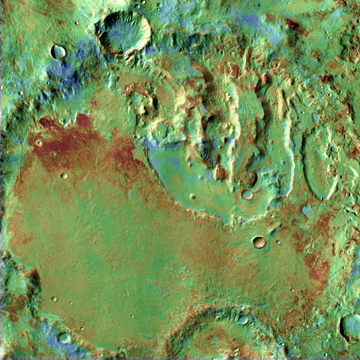 NASA/JPL/Arizona State University
NASA/JPL/Arizona State University
|
|
FALSE COLORS derived from THEMIS data tell scientists about the nature of the ground in Terby Crater. Warmer colors indicate harder and rockier terrain, while cool colors show surfaces coated with sand and dust. Because this ancient crater contains sediments that may record traces of life, it is one of numerous potential landing sites for NASA's next Mars rover, the Mars Science Laboratory (MSL).
|
|
THEMIS Support for MSL Landing
Site Selection
Researchers at the Mars Space Flight Facility at Arizona State University are using data from the Thermal Emission Imaging System (THEMIS) to help scientists choose a landing site for the Mars Science Laboratory (MSL). This is NASA’s next-generation rover spacecraft, due for launch in 2009.
MSL’s mission is to collect Martian soil and rock samples and analyze them for organic compounds, looking for environmental conditions that could have supported microbial life now or in the past.
Following a workshop in summer 2006, scientists identified 36 candidate landing sites for further study. A second workshop in October 2007 narrowed the candidates to six. Scientists and engineers are now using THEMIS and other spacecraft resources to assess these more closely from the standpoint of flight safety and scientific value.
|
|
